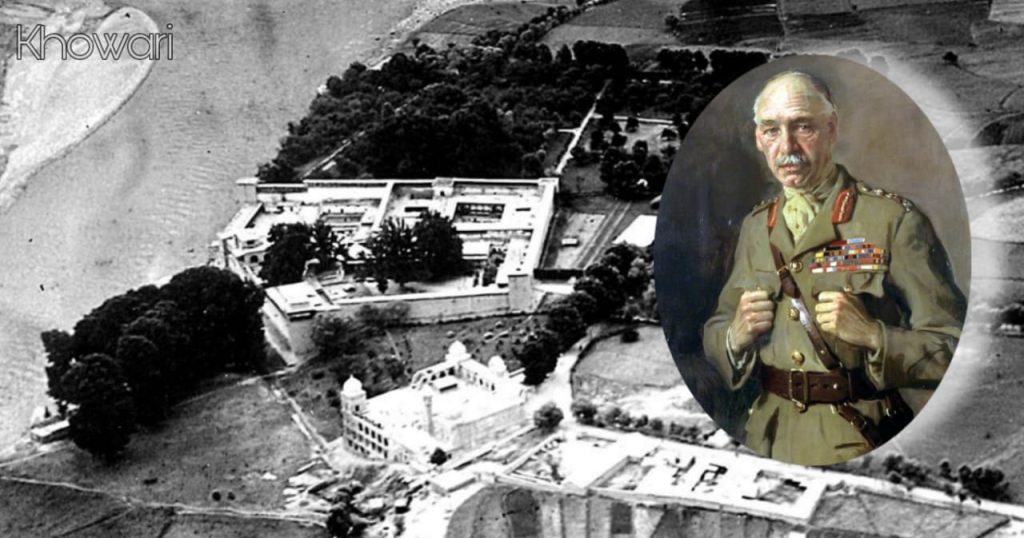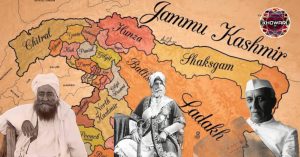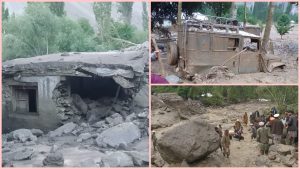1923: Visit of the Commander-in-Chief of Indian Army to Chitral

LIEUT.-COL. J. R. C. GANNON
(Being Extracts from a Diary of Gannon written during a journey made with Commander-in-Chief of the Indian Army H. E. Lord Rawlinson, through Dir, Chitral, and the Gilgit Agency in 1923.) Courtesy: The Himalayan Journal
As we reach the summit, the Chitralis push down the narrow road to meet us. They have come into Dir territory, so the Waliarhad and Saftar, followed by their myrmidons, push up as hard as they can into Chitral territory. Glorious confusion results while the Chief tries to shake hands and say ” How d’ye do ” to five of the Mehtar’s sons, two of his brothers, and umpteen ministers, at the same time as he is saying ” Goodbye ” to the now completely disgruntled Waliarhad and Saftar, who scowl, collect their riding ponies and hop it down the hill to Dir as fast as they can!
The five sons are a little disconcerting—all the same height and apparently the same age. However, we cut out Nasr-ul-Mulk, the eldest, and mark him down. The Chief inspects a guard of honour of the Chitral Scouts and bodyguard, all in khaki, with the local headdress of close-fitting puttoo with a rolled edge all round. Then down a steep road to Ziarat three miles away. The fir forest here is thicker than ever, and the mountains seem more massive. There is still snow in parts of the stream-bed—snow brown with mud and pine- needles, under which the stream cuts its way. This is the worst place for avalanches in winter. The bed packs up with thirty or forty feet of snow, and enormous avalanches come hurtling down the steep slopes. The road is closed, but stout-hearted men get through with the post. Twenty-four men were lost in one avalanche last year.
Ziarat, a simple rest-house of wood and mud. It is cool, a steady breeze sighs through the pines, and the stream bubbles below. Personally I am sincerely thankful to be out of Dir with its surly morose countrymen, who scarcely ever greeted the Chief. The possibility of an odd shot or two, in spite of the Nawab’s warm welcome, fired by some faction in order to get another into trouble, was always present. In Chitral all seem happy and cheerful. The Mehtar’s boys are jolly lads and delighted at meeting the Chief ; everyone bustles round cheerfully. Col. Tancred, commanding Chitral force and Captain Bowers, commanding the Chitral Scouts, Assistant Political Officer, met us.
Friday, 3rd August. Chitral. Left Ziarat after breakfast at 7 A.M. A steady incline down to Mirkani, gradually leaving the firs and getting back to holly and oak. At Mirkhani, a dilapidated- looking post, the road bends sharply to the right. In from the right comes the Chitral or Kunar river, a fine sight as it is large and runs at a great pace. Below Mirkhani it passes through a defile into Afghanistan. Facing the post is a high jagged range of hills which are the border of Kafiristan.
We halt for ten minutes. Some fine old Kafirs roll up to see the Chief. One old grey-beard is pointed out as having killed 130 Pathans in his time ; he is now a benevolent-looking old gentleman. Another is dressed in a long brown choga, with his head tied up in a handkerchief like a pirate of old ; a seared, lined old face, bright beady blue eyes, a hook nose and a fine scarlet beard make him a most picturesque figure.
We ride on down a steep hill to the river, then up the left bank towards Drosh. Gradually we leave the trees behind and massive rocky hills tower above us on each side. The last hour gives us a hot ride. The new ponies are small and not too fit, mostly Badakh- shanis. We reach Drosh Fort about 11-30 and have a welcome drink in the 4-12th Punjabis’ Mess. In the evening the Chief inspects the regiment. They are the old 24th Punjabis, a fine regiment ; also the Chitral Pack Artillery Section. The parade ground is on the far side of the river and we cross this by the best bridge in Chitral—a suspension bridge built by the Military Works at a cost of Rs. 25,000. It swings a bit as we go over. After parade the Chief inspects the lower fort where the S. and T. live…….A hot night. Chief and I slept well, but Glen and Hissam-ud-din attacked by fleas or worse.

On the move by 5 A.M. and it was just light as we rode down the hill and over the suspension bridge and turned up the right bank of the river. Fine hills each side of the river getting bigger and bigger as we go on. It got pretty hot and all of us were glad to get in to Ayun, where breakfast awaited us in a garden under the shade of some chinar trees. From here we got a view of Tirich Mir, a snow-covered peak of the Hindu Kush rising 25,700 feet above the sea. It is only 30 miles from Chitral. Not a cloud was on it this morning and it was very lovely. It has never been climbed ; indeed no Chitralis would go near it, as according to them it is infested with fairies.
We passed Gahirat at the 10th mile, a post on the left bank, and joined by a suspension bridge 50 feet off the water, but condemned now ; no one will cross it save a Chitrali or two on a windless day. The road just before Gahirat was a nasty bit, the river running in great strength through a rocky gorge, and the roadway cut three or four feet wide out of the rock. A slip, and you would fall forty feet into the torrent—a clear drop. All the ponies took it quietly enough. They seem to have a most boring habit of walking along the extreme outside edge of the path, due to carrying loads, I suppose.
Left Ayun for the eleven miles into Chitral. It is a hot, dusty, treeless ride till, coming round a bend, we see the road winding down to the river-bed and beyond it, on a plateau above the river, the trees and green fields of Chitral. A canter along the river-bed and we come up to a good road with willows each side, and after a little while to a grassy open space with a low hill behind it. A guard of honour in khaki is drawn up and beside them a pipe-band in scarlet and gold coats with blue trousers. Nasr-ul-Mulk meets the Chief with another host of sons, and on a hill behind hundreds of Chitralis fire off matchlocks into the air. A gun fires a salute at the same time ; it is a noisy 5 but warm welcome. The Chief dismounts and we stand in the shade of a tree and watch the local knuts trying to shoot the popinjay. This consists of two small silver balls at the top of a 15-foot pole. The lads of the village then gallop past in turn and take a pot-shot at the popinjay as they go by. There are a good many missfires, but at last some keen-eyed Chitrali rings the bell. Kafir dances follow. Kafir girls in pairs running round and round with the men dancing in pairs as well, the girls being dressed in a brown blanket with cowries sewn on to a head-dress of brown blanket.
More introductions. Kohistanis and Kafirs form up with petitions. At last we break away and march off, headed by the red and green bands and the guard of honour. We soon reach the bazar, a single street of wooden and mud huts. A sharp turn to the right and we come to the palace, which is gaily decorated. At an outer entrance stand the last batch of sons ranging from ten years of age down to two—quite wee ones who can just stand—all dressed in green with the Chitrali head-dress. In the gateway on a bed lies Shuja- ul-Mulk, Mehtar of Chitral, looking very ill indeed. In spite of the Chief’s efforts to prevent it, he is assisted to his feet to welcome the Chief. He is sent back to bed as soon as possible and we go to our camp, a charmingly arranged affair in the palace gardens and on the river bank, with Tirich Mir right above us. The Chief has a regular pavilion, two large rooms and a bed-room running off it. We all have comfortable ” Swiss cottage ” tents and there is a large mess-tent as well. Lovely grass and trees all round. A welcome drink and a change and we settle down. This enormous row of sons entertain me. They are marvellously alike and the eldest is only a lad. Are there any sisters ? It appears there are, 26 of them, while the boys number 13—unlucky, but perhaps the Mehtar has another one up his sleeve. Curiosity gaining the upper hand, I ask one of the sons how his mother is. He replies rather vaguely that he has many mothers !
An easy afternoon. The Chief sketches Tirich Mir. Glen,, Hissam-ud-din and I have a look at the bazar which is thronged with good folk who have come in for the show. After dinner, dances by the light of a huge bonfire and a welcome bed.
Sunday, 5th August. Began yesterday splendidly by sleeping till 7-30. Several mails in so worked in the morning and afternoon. At 5 P.M. we paid a visit to the Mehtar, being taken through the palace to the room where he lay. He was looking bad, but better than on the day before. Chief told me to wire to Northern Command this morning for an expert doctor for appendicitis to be sent up at once. The Mehtar is much pleased.
Rode down to the polo-ground where sports were going on. After sports, polo. Mastuj plays Chitral. It is weird and wonderful. The ground is 40 feet wide with a low stone-wall along each side. The spectators are massed on the walls ; some sit with their legs inside on the ground. The length is about 200 yards and they play six a side. One back each side and the remainder rush in a mob after the ball. No rules : crossing, hooking sticks on the wrong side going on all the time. A pipe-band plays throughout; the chukker lasts for 20 minutes. When a goal is hit, the scorer picks up the ball in his stick-hand and gallops for the other goal. When in the centre he throws the ball up and has a prodigious welt at it while in the air, and generally hits it. Spectators frequently get hit or trodden on, but that seems to be more amusing than anything else.
Our turn comes next, and our four, including Hissam-ud-din, play four of the Mehtar’s sons. Thank goodness that Bowers has some normal polo-sticks, for theirs are of the oddest shape, the sticks being rammed into one end of the head instead of in the centre, and at a sharp angle. Great excitement. The Chief mounted on a fast little Arab, gets going and scores almost at once, amidst shouts of joy. I tittup round after him on an animal that trots with great difficulty. The ponies average 13.2 and our colossal Hissam-ud-din is hurt that his animal won’t go faster. Glen rides the opposing back all over the place, which he doesn’t understand, and we beat the boys in a 20-minute chukker by 5 goals to love. The losing side is supposed to dance for the benefit of the winners, but the boys won’t turn out !
After dinner more dances, both Chitrali and Kafir. The Black Kafirs do their dance in pairs and now get a move on, both men and women doing their curious shuffle. These Kafirs are very interesting.. They are very fair and have no ordinary religion except those who have been converted to Muhammadanism. They seem to have been here since before the beginning of time, even before the Buddhists. They live entirely by grazing a few goats and cattle in their valleys. Numbers of them are still armed with bows and arrows. Polygamy is practised, and their dead are placed in a box on a high hill with their best clothes on, a little money and food, and are left there. They hate all Pathans. Wish I could remember Kipling’s ” Man who would be King.” I know the scene was in Kafiristan.
The Red Kafirs do a turn next. This is most perplexing. They stand in a circular crowd and one of them gives the note. They then start singing a definite tune of two lines, something like a Gregorian chant, in a major key. I ask Nasr-ul-Mulk what it all means and he tells me that this dancing is all their religion, and that the words mean ” We are dancing in praise of God ; we do not know how else to praise Him.” As they get warmed up they move round in a circle marking time with their feet in a sort of double shuffle. There follows another turn by Kafirs, two of them fooling with hobby-horses and wearing huge beards and lungis. After a Chitrali dance, a man lies down on the ground and does a Punch and Judy show with puppets, representing a boy and a girl. It is an old story, the boy making love to the girl and getting rebuffed, and the girl making up to him again. It is cleverly done and ends, needless to say, in a manner that would be considered somewhat indelicate in a Western country, but which is received with roars of natural merriment in this distant corner of the East.
Read the full Article: A Frontier Tour


